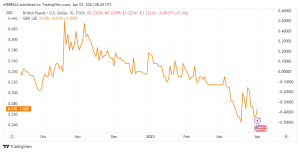The GBPUSD pair begins the new week on a negative note, retreating further from its highest level since January 26 in the 1.2420-1.2425 range touched on Friday. For the second day in a row, the US Dollar (USD) gains strong positive traction on speculation that a surprise production cut by OPEC+ will push inflation higher and force the Federal Reserve (Fed) to resume its inflation-fighting rate hikes. Indeed, major oil producers announced a further cut in output of around 1.16 million bpd on Sunday, causing the commodity to rise nearly 6% ahead of a virtual meeting of the OPEC+ ministerial panel. This, to a greater extent, overshadows the softer Personal Consumption Expenditures (PCE) Price Index data from the United States. Bets on a 25 basis point increase at the next FOMC policy meeting in May.
The prospect of further BoE tightening may lend support to the pair and limit losses.
The prospect of further Fed policy tightening is bolstered by a modest increase in US Treasury bond yields. Which helps the USD gain over 0.5%, dragging the GBPUSD pair lower. Spot prices fall to a one-week low. But the downside appears to be mitigated by bets on the Bank of England raising interest rates further (BoE). Indeed, Bank of England Governor Andrew Bailey stated last week that if there are signs of persistent inflationary pressure. Interest rates may have to rise. In addition, the final UK GDP print released on Friday showed that the economy expanded by 0.1% in the fourth quarter. And avoided a technical recession, reinforcing the Bank of England’s hawkish outlook. As a result, aggressive bearish traders should exercise caution before positioning for larger losses.
Market participants are now anticipating important US macro data at the start of a new month. The US ISM Manufacturing PMI. Due later during the early North American session on Monday, could drive USD demand. And provide some impetus to the GBPUSD pair, kicking off a rather busy week. This week, investors will also face the release of JOLTS Job Openings on Tuesday. The ADP report on private-sector employment and the ISM Services PMI on Wednesday. And the crucial US monthly employment report – popularly known as the NFP report. The latter will be crucial in influencing the near-term USD price dynamics. And assisting investors in determining the next leg of the major’s directional move.
GBPUSD Technical Analysis
Technically, the GBPUSD pair is currently trading near the 1.2275 level. Flirting with the 23.6% Fibonacci retracement level of the recent rally from the March swing low. Sustained weakness below could push spot prices towards the 1.2200 round-figure level. On the way to the 1.2180-1.2170 strong support. Which corresponds to the 38.2% Fibo. level.
Some follow-through selling will expose the 100-day Simple Moving Average (SMA) support, which is currently located between 1.2130 and 1.2125. This is closely followed by the 50% Fibo. level, which is located around the 1.2115-1.2110 area, below which the downward trajectory may continue towards the 1.2040 region (61.8% Fibo. level) and the 1.2000 psychological mark.

On the other hand, the 1.2300 round-figure mark appears to be acting as an immediate barrier ahead of the 1.2340 range.
A sustained move above should allow the GBP/USD pair to reclaim the 1.2400 level and test a multi-month high in the 1.2420-1.2425 range. The subsequent strength should pave the way for a move towards the psychological 1.2500 level, which, if decisively cleared, will be seen as a new trigger for bullish traders.









